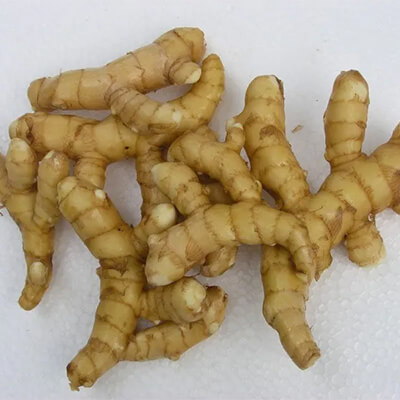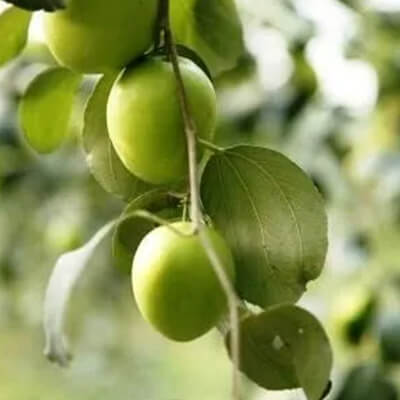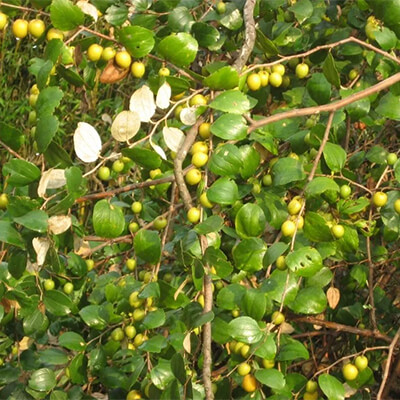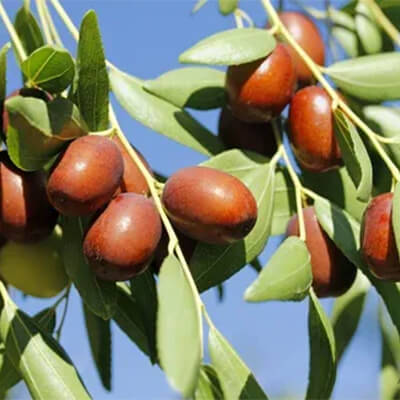On This Page
Amragandhi Haridra – A Spice having Raw Mango Flavor
Introduction of Amragandhi Haridra (Curcuma Amada)
Amragandhi Haridra is a rhizomatic aromatic herb that has a raw mango flavor and has a morphological resemblance to ginger. Amragandhi Haridra is popularly known as mango ginger and is an untapped medicinal plant of the ginger family. Amragandhi Haridra is widely distributed in the tropics of Asia to Africa and originated in Indo- the Malaya region. The rhizomes of Curcuma amada are a popular spice due to their flavor which is similar to the raw mango with a subtle earthy aroma. Amragandhi Haridra has active constituents like phenolic acids, terpenoids, curcuminoids, difurocumenonol, amadannulen, amadaldehyde, etc. due to which it exhibits cytotoxic activity, anti-allergic activity, brine- shrimp lethal activity, CNS depressant, analgesic activity, etc. As per Ayurvedic literature, Amragandhi Haridra is used in various disorders like Hikka, Shwasa, Kandu, Kustha Roga and is an appetizer, expectorant, antipyretic, aphrodisiac, etc.
*One other variety of Haridra that is studied along with Amragandhi Haridra is Aranya Haridra or Vana Haridra i.e Curcuma aromatica.
Introduction of Curcuma aromatica i.e Aranya Haridra / Vana Haridra
Vana Haridra or Aranya Haridra is botanically known as Curcuma aromatica Salisb. is a wild perennial herb of the ginger family i.e Zingiberaceae (Scitaminaceae). Its aromatic rhizomes are used traditionally to cure various disorders and are commonly known as Kasturi Manjal. Vana Haridra has various active constituents like flavonoids, curcuminoids, Tannin, terpenoids, alkaloids, etc. due to which it exhibits anti-diabetic, anti-acne, anti-cancerous, antitussive, antioxidant, and wound healing activity, etc. In Chinese medicine, this herb is a potential anticancer herb used to treat disorders with blood stasis. In India traditionally Aranya Haridra is used as an antidote for snakebite. It is astringent, tonic, and carminative and used to treat indigestion, rheumatism, fractured bone, helminths infection, etc.
Basonym of Amragandhi Haridra
आम्र गंधवत गंधमस्त्यस्या: हरिद्रा तुल्य रूपं कंदे |
Rhizomes of Amragandhi Haridra (Curcuma amada Roxb.) have got mango odor.
Synonyms of Amragandhi Haridra
- According to morphology
बृहत् कंदली- Rhizomes of Amragandhi Haridra are larger when compared to Haridra.
- According to properties and action
सुगंध- Rhizomes of Amragandhi Haridra have an aromatic odor.
कर्पूर हरिद्रा- Rhizomes of Amragandhi Haridra have got a similar odor to that of Karpura (Camphor).
Synonyms of Aranya Haridra / Vana Haridra
Arnya Haridra, Vana or Vanya Haridra, Karpura Haridra, Aranya Haldi Kand, Darvi Bheda, Asragandha , Surbhi Daru, Daru
Regional Names of Amragandhi Haridra
- Mango ginger (English)
- Ama Haldi, Amba Haldi, Safed Haldi (Hindi)
- Ambekombu (Kannada)
- Mangayiryi (Malayalam)
- Aamba Haldi, Pandhari Haldi (Marathi)
- Mamidi Allam, Karu Vasupu (Telugu)
- Samidi Allam (Tamil)
- Safed Haldar (Gujarati)
- Amarada (Bengali)
- Mabaz (Arabic)
- Darchuha (Pers.)
- Ambahaladi (Urdu)
- Amkladrak (Deccan)
- Ambahaldi (Canerese)
More names Amragandhi Haridra, Amradrakam and Karpura Haridra (Sanskrit).
Regional Names of Aranya Haridra / Vana Haridra
- Wild turmeric, Cochin turmeric, yellow zedoary (English)
- Ban Haldi, Kapur Haldi, Jangali haldi (Hindi)
- Banhalud (Bengali)
- Badanhald (Bombay)
- Kasturiarishma (Canarese)
- Kapur Kachali, Vana Haladara (Gujrati)
- Banhallad (Konkan)
- Anskuma, Kattumammar (Malayalam)
- Banhalda (Marathi)
- Kasturi Manjal (Tamil)
- Judwar (Arabic)
- Darchouba (Persian)
Botanical Name of Aamragandhi Haridra
Curcuma amada Roxb.
Curcuma belongs to the turmeric genus, Curcuma is an Arabic name for turmeric.
Amada word is derived from the Bengali vernacular name meaning Mango.
Botanical Name of Aranya Haridra/ Vana Haridra
Curcuma aromatica Salisb.
Curcuma belongs to the turmeric genus, Curcuma is an Arabic name for turmeric.
Aromatica means fragrance.
Family – Zingiberaceae/ Scitaminaceae (Ardraka Kula)
Ayurveda reference for Amragandhi Haridra (Curcuma amada Roxb.)
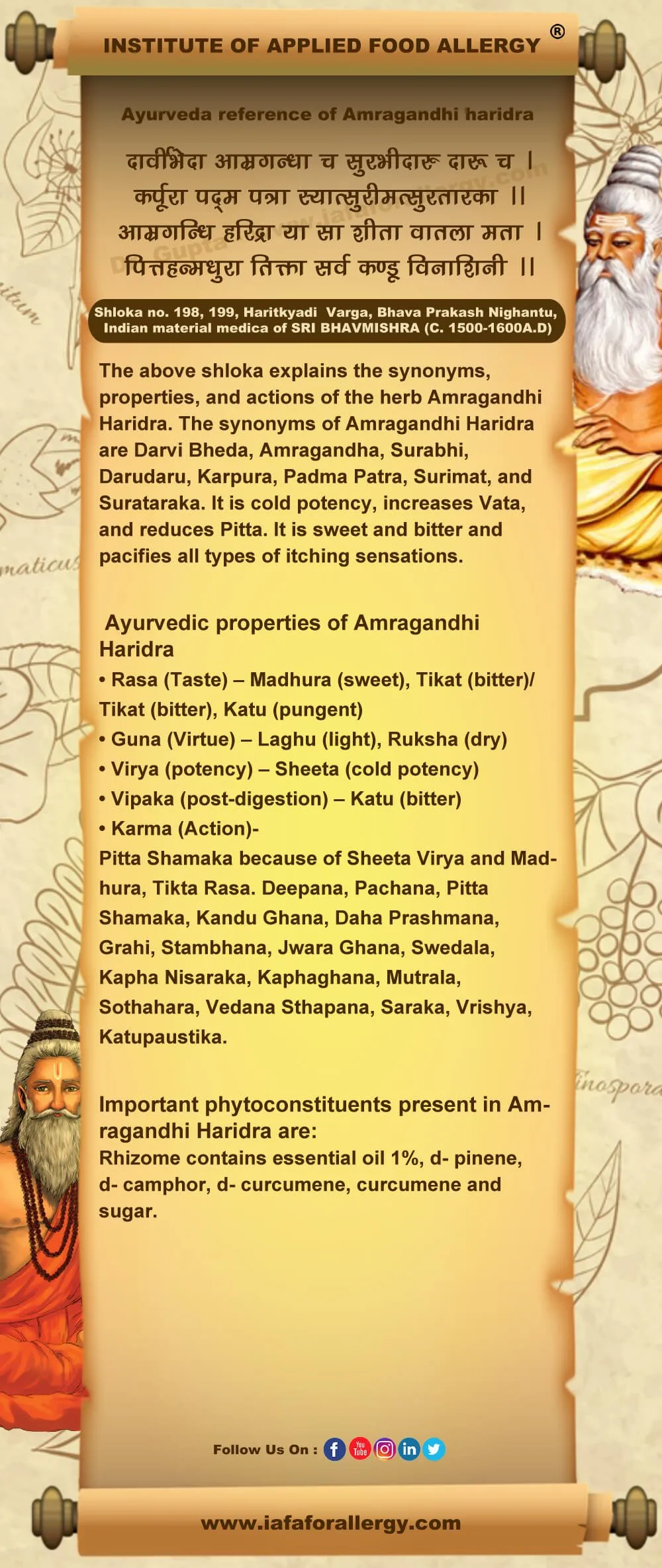
Ayurveda reference for Aranya Haridra/ Vana Haridra (Curcuma aromatica Salisb.)
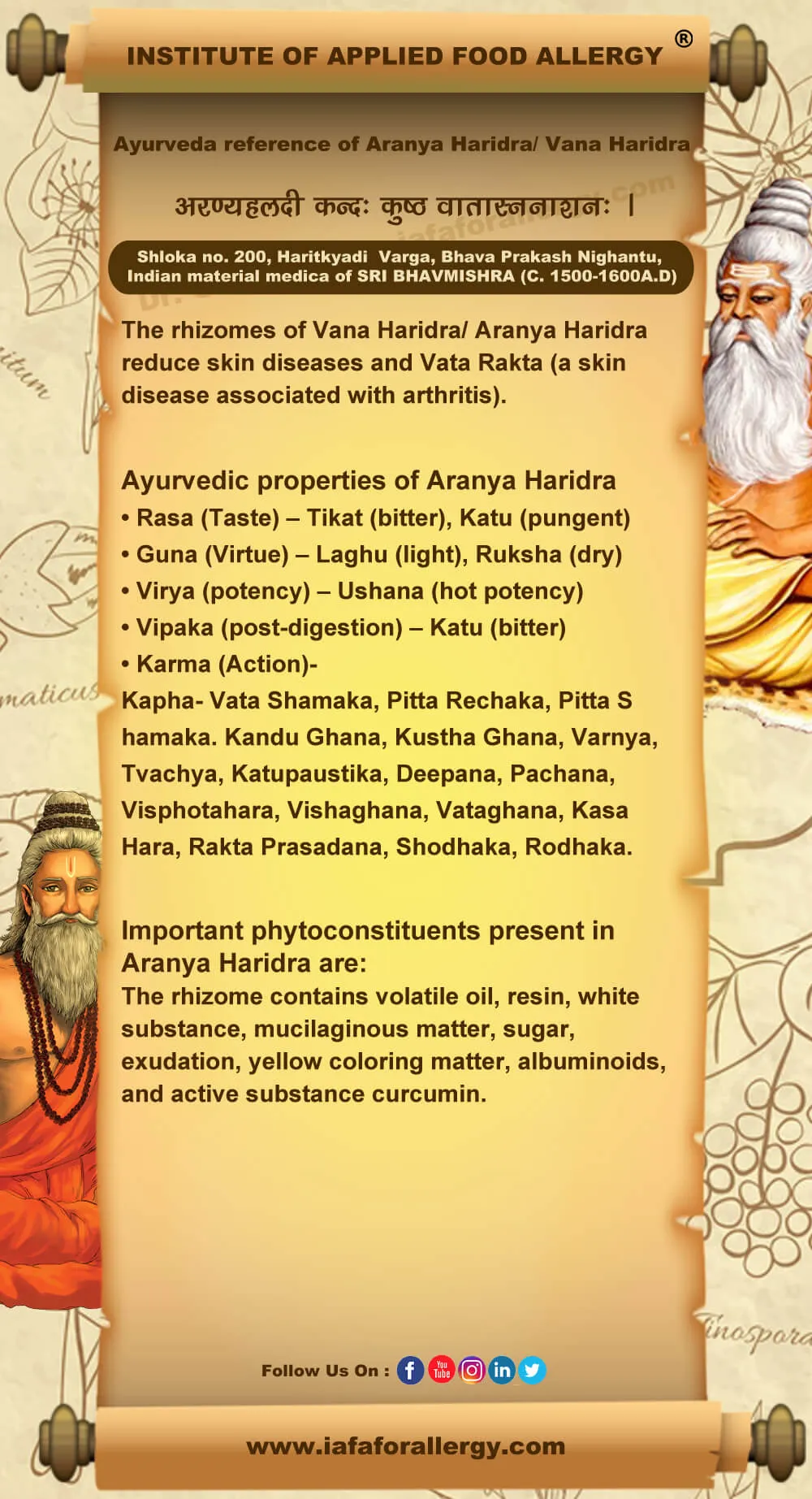
Scientific classification of Amragandhi Haridra
| Kingdom | Plantae |
| Class | Monocotyledons |
| Series | Epigyne |
| Family | Zingiberaceae/ Scitaminaceae |
| Genus | Curcuma |
| Species | amada |
Scientific classification of Aranya Haridra/ Vana Haridra
| Kingdom | Plantae |
| Class | Monocotyledons |
| Series | Epigyne |
| Family | Zingiberaceae/ Scitaminaceae |
| Genus | Curcuma |
| Species | aromatica |
Classification of Amragandhi Haridra/ Aranya Haridra as per Charaka and Sushruta
- Charaka: Not included in Mahakshaya.
- Sushruta: Not included in Gana.
Amragandhi Haridra’s & Aranya Haridra’s description in Brihtrayi
No description of Amragandhi Haridra, Aranya Haridra is available on Brihtrayi.
Historical background of Amragandhi Haridra
It is a perennial herb bearing light yellow flowers and rhizomes with a mango aroma. It is cultivated abundantly all over India. It is not described in the Brhat Trayi texts but Nighantus like Bhava Prakasha mentioned it.
External morphology of Curcuma amada Roxb.
- Habit – A herb, with large rootstock, tubers are sessile and thick, cylindric or ellipsoid shaped, pale-yellow colored inside.
- Leaf – Seen in tufts, long petiole, the blade is 30 to 45 cm long and 7 to 12 cm wide, oblong-lanceolate, acute tip, narrowed to the base, glabrous, and green on both the sides. Petioles as long as the leaf blade (30-45 cm.)
- Inflorescence – Spike inflorescence with a long peduncle.
- Flowers – Flowers are white or very pale yellow. Flowers in autumnal spikes 7.5-15 by 3.8-5 cm. in the center of the tuft of leaves, peduncle 15 cm. long or more, flowering bracts 2.5 cm. long, greenish-white, bracts of the coma longer and narrower, tinged with pink or red, Calyx nearly 13 mm. long, obtusely 3-toothed. Corolla white or very pale yellow; tube about 2.5 cm. long; lobes oblong, acute. Lip semi-elliptic, yellow, 3-lobed, the middle lobe emarginate.
- Rootstock large sessile tubers thick, cylindric or ellipsoid, pale yellow inside. Rootstock smells like the odor of mango fruit and appears like a ginger rhizome, and the source plant resembles turmeric herb; these features combine in the popular name Mango-Ginger, in the category of Turmeric drugs group.
- Flowering and fruiting time
Flowering: August- September
Fruiting: October
External morphology of Curcuma aromatica Salisb.
- Habitat: Herb.
- Root: Rootstock large, of palmately branched, sessile, annulate biennial tubers yellow and aromatic inside.
- Leaves: Leaves are 38- 60 by 10- 20 cm., oblong-elliptic or oblong-lanceolate, caudate-acuminate, green, often variegated above, pubescent beneath, base deltoid, petioles as long as or longer than the blade.
- Flowers: Flowering stem appearing with or before the leading stem, as thick as the forefinger sheathed. Flowers fragrant, shorter than the bracts, in spikes 15-50 cm., long; flowering bracts 3.8- 5 cm. long, ovate, recurved, cymbiform, rounded at the up, pale green, connate below forming pouches for the flowers; bracts of the coma 5.7- 5 cm. long, more or less tinged with red or pink, Calyx 8 mm. long, irregularly 3-lobed. Corolla-tube 2.5 cm. long, the upper half funnel-shaped, lobes pale rose-colored, the lateral lobes oblong, the dorsal longer, ovate, concave, arching over the anthers. Lip yellow, obovate, deflexed, sub entire, or obscurely 3-lobed. Lateral staminodes are oblong, and obtuse, as long as the corolla lobes.
Flowering and fruiting time
Summer season. The plant appears like a Turmeric herb, rhizome-like potato (inside orange color and thick), and smelling like camphorous odor, and these features combine in its popular name.
Distribution of Amragandhi Haridra
Curcuma amada is found under cultivation in many parts of India including Gujarat, Maharashtra, Kerala, Karnataka, Tamil Nadu, Andhra Pradesh, Orissa, and West Bengal. The plant is also cultivated in the Malay Peninsula and Archipelago.
Distribution of Aranya Haridra
Bengal, Western Peninsula; wild and sometimes cultivated. It is found almost throughout India, especially in Mysore, and Malabar forests; also cultivated in various parts of the country.
Adulterant of Amragandhi Haridra
Curcuma zedoaria Rosc.
The useful part of Amragandhi Haridra
- Kanda (Rhizome).
Rhizome laterally flattened, longitudinally wrinkled, 2 to 6 cm long, 0.5 to 2 cm in diameter, branched, a remnant of scaly leaves arranged in a circular manner giving the appearance of growth rings. Cut pieces 1.5 to 3.5 cm in diameter, circular, having punctate scars on the surface. The rhizome is buff-colored with short and smooth fractures. The odor and taste are like raw mango.
The useful part of Aranya Haridra
- Kanda (Rhizome)
Important phytoconstituent of Amragandhi Haridra
Rhizome contains essential oil 1%, d- pinene, d- camphor, d- curcumene, curcumene, and sugar.
Important phytoconstituent of Aranya Haridra
The rhizome contains volatile oil, resin, white substance, mucilaginous matter, sugar, exudation, yellow coloring matter, albuminoids, and active substance curcumin.
Recent research on Amragandhi Haridra
- Curcuma amada Roxb. is an important species known as Mango ginger due to its characteristic aroma of raw mango. The rhizome is rich in essential oils and more than 130 chemical constituents with bio-medical significance have been isolated from it. Also, it has given positive results when investigated for its antibacterial, insecticidal, antifungal, and antioxidant properties. Jatoi SA, Kikuchi A, Gilani SA, Watanabe KN. Phytochemical, Pharmacological, and ethnobotanical studies in Mango ginger (Curcuma amada Roxb; Zingiberaceae). Phyto Res. 2007 June; 21 (6): 507- 16.)
- A significant decrease was observed in liver total lipids and serum triglycerides of adult female rats when fed 10.0% mango ginger or 10.0% curcumin along with a normal diet or a sucrose-based hypertriglyceridemia diet. (J. Food Sc). Techno, 1992, 29, 130).
- The ethereal extract of rhizomes in a dose of 1 g. given orally in the form of aqueous suspension could lower the blood cholesterol level in rabbits (Pachauri and Mukherjee, 1970).
- Antioxidant activity
- Antibacterial activity
Recent research on Aranya Haridra
- Anti-tumor activity
- Anti–cancer activity
- Wound healing activity
- Antitussive activity
- Anti-platelet activity
- Anti-nephrotoxic activity
- Radical scavenging activity
- Antioxidant activity
Rasa Panchaka of Amragandhi Haridra
| Rasa (Taste) | Madhura (sweet), Tikat (bitter)/ Tikat (bitter), Katu (pungent) |
| Guna (Virtue) | Laghu (light), Ruksha (dry) |
| Virya (potency) | Sheeta (cold potency) |
| Vipaka (post-digestion) | Katu (pungent) |
Rasa Panchaka of Aranya Haridra/ Vana Haridra
| Rasa (Taste) | Tikat (bitter), Katu (pungent) |
| Guna (Virtue) | Laghu (light), Ruksha (dry) |
| Virya (potency) | Ushana (hot potency) |
| Vipaka (post-digestion) | Katu (pungent) |
Dosha Karma of Amragandhi Haridra
- Pitta Shamaka because of Sheeta Virya and Madhura, Tikta Rasa.
Dosha Karma of Aranya Haridra
- Kapha Vata Shamaka, Pitta Rechaka, Pitta Shamaka (Tridoshahara)
Karma (Actions) of Amragandhi Haridra
Deepana, Pachana, Pitta Shamaka, Kandu Ghana, Daha Prashmana, Grahi, Stambhana, Jwara Ghana, Swedala, Kapha Nisaraka, Kaphaghana, Mutrala, Sothahara, Vedana Sthapana, Saraka, Vrishya, Katupaustika.
Karma (Actions) of Aranya Haridra
Kandu Ghana, Kustha Ghana, Varnya, Tvachya, Katupaustika, Deepana, Pachana, Visphotahara, Vishaghana, Vataghana, Kasa Hara, Rakta Prasadana, Shodhaka, Rodhaka.
Prayogarha Vyadhi (Therapeutic indication) of Amragandhi Haridra
- Kasa
- Shvasa
- Hikka
- Jvara
- Sannipataja Jvara
- Tvagvikara
- Kandu
- Pama
- Sotha
- Abhi Atajan Yasotha
- Vedana
- Vrana
- Gridhrasi
- Mukha Roga
- Mukha Paka
- Karna Roga
- Mutra Vikara
- Mutra Kriccha
- Hrid Vikara
- Atisara
- Agnimandya
- Arochaka
- Daurbalya
Prayogarha Vyadhi (Therapeutic indication) of Aranya Haridra
- Kustha
- Shweta Kustha
- Masurika
- Vata Vikara
- Kandu Visphot
- Jwara
- Kasa
- Rakat Pradoshaja Vikara
- Rakta Shuddhi
- Abhighata Janya Roga
- Vedana
- Visha
- Sarpa Visha
Aamyik Paryog (Therapeutic uses) of Amragandhi Haridra
- Shwitra (Leucoderma) – The powder is administered internally in the treatment of Shwitra. (Nighantu-Adarsha)
- Kandu (Itching): Rhizome of Amragandhi Haridra (Curcuma amada) is made into a paste and applied externally to cure all kinds of Kandu (Itching).
- The rhizome is useful as a bitter, cooling, astringent, laxative, and anodyne. It is used as an antiphlogistic or countering drug against inflammatory and painful conditions and traumatic troubles.
- Roots are useful as an alexiteric and aphrodisiac.
- The rhizomes are a popular remedy for sprains and contusions, and other traumatic complaints. The paste, powder, and another suitable form with adjuvants are applied topically on the affected body organs, for relieving inflammation, pains, and other complications.
- It is also useful in lumbago and nervine pains.
- The roots are externally applied to scabies, itchy affections, ulcers, sores, and other skin diseases, and also troubles in the mouth, ear, penis (ulceration), and gleet. It is recommended for all kinds of itching and cutaneous affections.
The rhizomes are useful in cough, asthma hiccup, heart troubles, biliousness, constipation, dyspepsia, and diarrhea.
Aamyik Paryog (Therapeutic uses) of Aranya Haridra
- The rhizome is useful as a bitter tonic, appetizer, antidote to venom, blood purifier, tonic, carminative, antiphlogistic, analgesic, and some other ailments. It is generally used externally.
- The rhizome is used in general debility as tonic and stomach troubles, dyspepsia, and anorexia as carminative. (The rhizome is considered useful for administering in small doses, (also with costus and carum) in snakebite as an antidote against snake bite.
- Rootstock is used externally in skin diseases, scabies, eruption of smallpox, and itch. It is useful in leucoderma and diseases of the blood caused by its impurities.
- It is applied to promote the eruption or exanthematous fevers, it is seldom used alone but is combined with astringent when applied to bruises, and with bitters and aromatics to promote eruptions.
- The rhizome is considered a common remedy by rubbing into a paste with benzoin on the forehead for headaches.
Benefits of Curcuma amada
- Obesity (Medo Roga): Study on Amragandhi Haridra revealed that it exhibits anti- hypercholesteremic activity which helps to manage obesity. As per Ayurvedic texts, Amragandhi Haridra has Kapha balancing properties and along with this due to its Deepana and Pachana properties, it helps to digest the accumulated Ama (toxins) from the body. Thus, helps to manage high cholesterol levels and obesity.
- Arthritis (Amavata): As we know that deficiency of magnesium may result in a disorder of bony cartilaginous growth which in turn leads to arthritis and immune deficiency disorder. Amragandhi Haridra exhibits antioxidant activity and along with this rich in magnesium which helps in collagen production helps in developing healthy bones, healing wounds, relive in bone fracture, arthritis, immune deficiency disorders, etc.
- Skin diseases (Kustha Roga): Curcuma amada exhibits anti-fungal, antibacterial properties, anti-microbial, etc. due to which it is a marvelous remedy for skin disorders. Along with this Amragandhi, Haridra is rich in antioxidants and Pitta pacifying properties thus helping to treat Mukha Dushika (Acne), Vyang (blemishes), dark circles, etc.
- Gastrointestinal issues (Aamashyagata Roga): Amragandhi Haridra exhibits Deepana, and Pachana properties and this recent research revealed that Curcuma amada exhibits anti-ulcer properties. Therefore, Amragandhi Haridra helps to treat various gastric issues like abdominal gas, indigestion, gastric ulcers, etc.
- Respiratory disorders (Swashavaha Srotas Vyadhi): Amragandhi Haridra with its Kapha Nisaraka properties helps to treat various respiratory disorders. Recent studies proved that Curcuma amada exhibits antitussive activity thus an ideal remedy to cure cough and asthma.
Benefits of Curcuma aromatica
- Cancer (Arbuda): Vana Haridra is a storehouse of antioxidants and also exhibits anti-cancer activity as per recent research. Due to these properties, Vana Haridra combat-free radicals lessen the growth and formation of tumor cells and lessen the risk of developing certain kinds of cancer.
- Cough (Kasa): Aranya Haridra exhibits anti-inflammatory and antioxidant properties. These properties of Curcuma aromatica help to ease a sore throat, and chest congestion and cure cough.
- Wound healing (Vrana Ropana): Aranya Haridra consists of active compounds which help in cell generation, and the healing process, and also help in curing scar tissues. Vana Haridra is very useful in curing scars, snake bites, scrapes, etc.
- Aging (Jara): Vnaa Haridra exhibits antioxidant properties, anti-microbial, and anti-inflammatory properties due to which it treats oxidative free radical damage and helps in averting the signs of aging like wrinkles, dark spots, fine lines, etc.
Matra (Therapeutic administration and dosage) of Aranya Haridra
- Churna (powder): 1 to 3 grams
Matra (Therapeutic administration and dosage) of Amragandhi Haridra
- Swarasa (juice): 10- 20 ml
- Churna (powder): 1 to 3 grams

Have A Health Issue?
Consult Online
- Dr. Sahil Gupta (B.A.M.S., M.H.A.)
Ayurvedic Allergy Specialist
CEO & Founder of IAFA®
Classical reference of Amragandhi Haridra and Aranya Haridra
Bhava Prakasha Nighantu Haritkyadi Varga- 198
Synonyms
दार्वीभेदा आम्रगन्धा च सुरभीदारु दारू च |
कर्पूरा पद्म पत्रा स्यात्सुरीमत्सुरतारका ||
Bhava Prakasha Nighantu Haritkyadi Varga- 199
Properties and action
आम्रगन्धि हरिद्रा या सा शीता वातला मता |
पित्तहन्मधुरा तिक्ता सर्व कण्डू विनाशिनी ||
Kaideva Nighantu Aushadhi Varga- 1118
आम्र गन्धा हरिद्रा तु शीतला वातला तथा |
पित्तह्रत स्वादु तिक्ता च वृष्या स्यात्सन्निपातजित् ||
Bhava Prakasha Nighantu Haritkyadi Varga- 200
वनहरिद्रा
अरण्यहलदी कन्द: कुष्ठ वातास्ननाशन: |
Raja Nighantu Pipplyadi Varga, 88- 90
अरण्य- वनहरिद्रा- तवक्षीर:
तवक्षीरं पय: क्षीरं यवजं गवयोदूभलम् ।
अन्यद्गोधूमजं चान्यत्पिष्टिका तण्डलोदभवम् ||
अन्यंच्च तालसम्भूत तालक्षीरादिनामक्म |
वनगोक्षीरजं श्रेष्ठमंभावे अन्यदुदीरितम् ॥
तवक्षीर गुणाः
तवक्षीर तु मधुर शिशिरं दाहपित्तनुत् |
क्षयकासकफश्चासनाशनं चा अस्रदोषनुत् ||
Specific Formulation of Amragandhi Haridra
- Asthi Sandhanaka Lepa for Shotha and Asthi Bhagna.
Contraindication and side effects of Amragandhi Haridra and Aranya Haridra
No adverse effect has been reported after the use of Amragandhi Haridra and Aranya Haridra. Avoid the use of Amragandhi Haridra and Aranya Haridra during pregnancy and lactation or use them under medical supervision.
Suggestive reading regarding Curcuma aromatica
- Shamim A, Ali Mohammed, Ansari SH, Ahmed F. Phytoconstituents from the rhizomes of Curcuma aromatica Salisb. Journal of Saudi Chemical Society 2011; 15:287-290.
- Pant N, Misra H, Jain DC. Phytochemical investigation of ethyl acetate extract from Curcuma aromatica Salisb rhizomes. Arabian Journal of Chemistry 2013; 6:279-283.
- Vasavda K, Hedge PL, Harini A. Pharmacological Activities of Turmeric (Curcuma longa Linn): A Review. J Homeopathy Ayur Med 2013; 2(4):133.
- Saleem M, Daniel B, Murali K. Antimicrobial activity of three different rhizomes of Curcuma longa & Curcuma aromatic on uro- pathogens of diabetic patients. Int J Pharm Pharmacological Sci 2011; 3(4):273-279.
- Kuttiyil, Anoop. (2015). CURCUMA AROMATICA SALISB: A MULTIFACETED SPICE. International Journal of Phytopharmacy Research. 6. 10-15.
- Choochote W, Chaiyasit D, Kanjanapothi D, Rattanachanpichai E, Jitpakdi A, Tuetun B and Pitasawat B. Chemical composition and antimosquito potential of rhizome extract and volatile oil derived from Curcuma aromatica against Aedes aegypti (Diptera: Culicidae). J. Vector Ecol., 30, 2005, 302-309.
- Al- Reza SM, Rahman A, Sattar MA, Rahman MO and Fida HM. Essential oil composition and antioxidant activities of Curcuma aromatica Salisb. Food Chem. Toxicol., 48, 2010, 1757.
- Itokawa H, Shi Q, Aklyama T, Morris-Nltschke SL and Lee KH. Recent advances in the investigation of curcuminoids. Chin. Med., 3, 2008, 11.
- Gurdip S, Om Prakash S, Menut C and Bessiere JM. Studies on essential oils part 34: chemical and biocidal investigations on leaf volatile oil of Curcuma aromatica. J. Essent. Oil Bearing Plants., 7, 2004, 258-263.
- Reena Parida, Sujata Mohanty & Sanghamitra Nayak (2020) Chemical Composition and Anti-proliferative Activity of Essential Oil from Rhizomes of Micropropagated Curcuma aromatica in Eastern India, Journal of Biologically Active Products from Nature, 10:1, 1-7, DOI: 10.1080/22311866.2020.1737230
- Sangita P. Shirsat, Kaveri P. Tambe, Gayatri D. Patil, Ganesh G. Dhakad. Review on Curcuma aromatic as an Herbal medicine. Research Journal of Pharmacology and Pharmacodynamics.2022;14(2):89-2. doi: 10.52711/2321-5836.2022.00016.
Suggestive reading regarding Curcuma amada
- Samant, Lalit. (2012). Curcuma amada Roxb.: A Phytopharmacological Review. Journal of Pharmacy Research. 5. 1992- 1993.
- Ayodele, Victor & Olowe, Olumayowa & Afolabi, C. & Kehinde, Iyabo. (2018). Identification, Assessment of Diseases and Agronomic Parameters of Curcuma amada Roxb (Mango ginger). Current Plant Biology. 15. 10.1016/ j.cpb. 2018.10. 001.
- Ramachandran, Cheppail & Portalatin, Gilda & Quirin, Karl-Werner & Escalon, Enrique & Khatib, Ziad & Melnick, Steven. (2015). Inhibition of AKT signaling by supercritical CO2 extract of mango ginger (Curcuma amada Roxb.) in human glioblastoma cells. Journal of complementary & integrative medicine. 12. 10. 1515/jcim-2015- 0005.
- Ayodele, Victor & Olowe, Olumayowa. (2019). Morphological Traits and Nastism of Mango Ginger (Curcuma Amada Roxb.). Agricultural Science Digest – A Research Journal. 39. 10. 18805/ag. D- 140.
- Bhaskaran, Arun & Rao, S. & Subrahmanya, P. & S, Mahesh & m.s, Krishnamurthy. (2012). Clinical evaluation of Amragandha Haridra (Curcuma amada Roxb) in Pratishyaya W.S.R to Allergic Rhinitis: A folklore claim. International Journal of Research in Ayurveda and Pharmacy. 3. 85- 89.
- Chen, Y., Shukurova, M. K., Asikin, Y., Kusano, M., & Watanabe, K. N. (2020). Characterization of Volatile Organic Compounds in Mango Ginger (Curcuma amada Roxb.) from Myanmar. Metabolites, 11 (1), 21. https:// doi. org/ 10. 3390/ metabo11010021.
- Tamta A., Prakash O., Punetha H., Pant A.K. Chemical composition and in vitro antioxidant potential of essential oil and rhizome extracts of Curcuma amada Roxb. CogentChem. 2016;2.
- Srivastava A.K., Srivastava S.K., Shah N.C. Constituents of the Rhizome Essential Oil of Curcuma amada Roxb. from India. J. Essent. Oil Res. 2001; 13: 63– 64. doi: 10.1080/10412905.2001.9699608.
- Varadarajan R., Mathew M.C.R., Souprayan S. Hepatoprotective efficacy of ethanolic extracts of rhizome Curcuma amada Roxb. In experimental rats. Ann. Plant Sci. 2018; 7:1966. doi: 10.21746/aps.2018.7.1.9.
- Nagavekar, Nupur & Singhal, Rekha. (2019). Supercritical fluid extraction of Curcuma longa and Curcuma amada oleoresin: Optimization of extraction conditions, extract profiling, and comparison of bioactivities. Industrial Crops and Products. 134. 134-145. 10.1016/j.indcrop.2019.03.061.
- George, C. & Shirin, H. & Varghese, R. & Priya, Charles & Rao, Bhaskar. (2013). Phytochemical composition, antioxidant studies, and HPTLC analysis of a methanolic extract of Curcuma amada Linn. Research Journal of Pharmaceutical, Biological, and Chemical Sciences. 4. 1187-1195.
References
- Bhavamishra. In: BhavaPrakasha Nighantu, Haritkyadi Varga 11th ed. part 2. Brahma Shankara Mishra., editor. Varanasi: Chaukhambha Bharati Academy; 2009.
- Bhavprakasha, commentary by Bulusu Sitaram, forwarded by K.C.Chunekar
- Sharma PV, Kaideva Nighantu. Aushadhi Varga. Chaukhamba Orientalia, Varanasi; 2006:
- Tripathi I., Raja Nighantu, Pipplyadi Varga, Chaukhamba Krishnadas Academy; Varanasi; 2010
- Dr. Gyanendra Pandey, Dravyaguna Vigyana, reprint 2012, Chawkhamba Krishnadas Academy
- K. Niteshwar Dravyaguna Vigyan, reprint 2017.
- Nighantu Adarsha.
- Dr. J.L.N. Sastry and Dr. B.S. Sastry, Dravyaguna Vigyana, Chaukhambha Orientalia, Varanasi.
- Chakrapanidatta, Chakradatta with the vaidya Prabha hindi commentary by indra deva tripathi, chaukambha sankrita sansthan, varanasi 2nd Edition, 1994.
Ayurveda is an Indian system of medicine that is popular since ancient times. Dr. Gupta’s IAFA® has been conducting research studies to find out different phytoconstituents of herbs and their action in the body. Such knowledge acquired by our experts is used in the preparation of medicines and providing the treatment facilities safely and effectively. IAFA® is the provider of safe and effective treatment for a wide range of diseases, mainly allergic diseases all based on Ayurveda.

